Satyagraha House | |
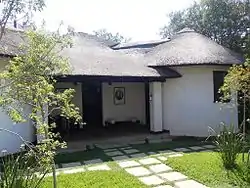 the Kraal | |
| Established | 1 January 2007 |
|---|---|
| Location | 15 Pine Road, Orchards, Johannesburg |
| Coordinates | 26°09′09″S 28°04′28″E / 26.152539°S 28.074392°E |
| Type | Johannesburg's historical heritage |
| Curator | Lauren Segal |
| Website | satyagrahahouse |
Satyagraha House, commonly known as Gandhi House, is a museum and guest house located in Johannesburg. The house belonged to Mahatma Gandhi: he lived and worked there between 1908 and 1909. It is registered as part of Johannesburg's historical heritage. Satyagraha means insistence on truth. The house was designed by the architect Hermann Kallenbach for Gandhi and himself.
History
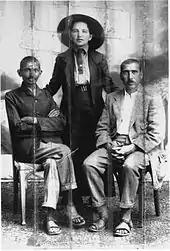
Gandhi spent 21 years in South Africa, from 1893 until 1914, although he made visits to India and the UK during that time.[1] It is said that Gandhi first learnt about racial discrimination when he was arrested at Pietermaritzburg railway station for travelling in a whites only wagon.[2]
In 1904, Gandhi met Hermann Kallenbach, a German-Jewish architect who had arrived in the country in 1896. In 1907, Kallenbach designed a house that was based on the shape of two local huts (rondavels)[3] but made with European building methods. It was named the Kraal, which means barn in English and Afrikaans.
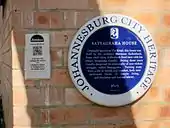
The house had stables and a tennis court, but both of them led a life of meditation and chastity. Gandhi slept in an attic room which he entered via a ladder, but he and Kallenbach shared the same kitchen and entertained their guests in the living room. The houses did not have connecting doors, and it was necessary to leave one house in order to enter the other. Kallenbach's life was transformed by their life together and the money that he spent on himself was cut to a tenth of its initial figure.[4] They left in 1909, and the house had several owners[5] before being bought in 2009 by the French travel company Voyageurs du Monde to the chagrin of the Government of India who wanted to acquire it as an Indian national monument.[6] The French company had it restored and opened it to the public as a museum and guest house in 2011.
The museum is managed by Lauren Segal,[1] who also manages other museums, including the Apartheid Museum.[7] Satyagraha means "truth force", a reference to the concept of non-violent resistance developed by Gandhi when he lived in South Africa.[1]
Today
At the end of August 2009, the house, which was a classic family home, became the property of Voyageurs du Monde, and has been called Satyagraha House. It will therefore be classified as a heritage site for the city of Johannesburg and the Gauteng region.
This house belonged to the Ball family, a South African / American couple. They owned it since the early 1980s and saw their children grow up there.
This house is located in the Orchards neighborhood, neighboring the chic Houghton and Norwood neighborhoods. It is a middle-class residential area which remains pleasant with its deserted streets but lined with large trees (jacarandas). The house is located on Pine Road, a private street. In this small street there are four houses (two on each side) and a synagogue as well as a fairly large but undeveloped green space as well as a parking lot opposite this place of worship.
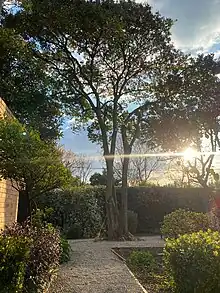
After 2 years of renovation and installation of the museum and the complete renovation of the garden, the house will open its doors to the public in August 2011.
It consists of the following elements:
• wooded land of a total of 1500m² with numerous species, flowers, trees and nooks and crannies.
• A building at the entrance which has a thatched roof and cut in two with a part (workshop) and another garage.
• A large gate also allows parking for two cars and access to a passage protected by trees with large foliage.
• A house: The house consists of an entrance hall with two bedrooms on each side located in outgrowths of the rondavel-shaped house. After this living room, we arrive in the current dining room, the most beautiful room in the house with a large bay window and visibility towards the “famous” mezzanine and high ceilings. On the left, you access the staircase to the mezzanine, a cellar and the original kitchen (now dedicated to the museum). Straight ahead, leaving the dining room, is a corridor which, on the right, leads to a charming bedroom also equipped with a small bathroom. Straight ahead and down a few steps is the large bedroom. Coming from an extension of the original building, this room is large and very bright. The floor of the house is original, tiles and parquet which will be preserved and renovated.
• The cottage: when you enter through the main pedestrian entrance to the right of the house there is a cottage built in the same style and very pleasant; you enter into a small living room with a fireplace which serves two bedrooms. The magnificent framework invites you to look up and consider a mezzanine. The atmosphere of this space is very pleasant.
The renovation
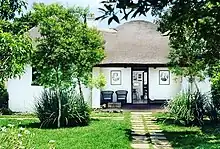
Satyagraha House becomes a place whose main function is to be dedicated to the memory of Satyagraha and Gandhi and this unknown part of South African history. A peaceful, simple, quiet place with objects, photographs, quotes which place the house in its history (the beginning of the 20th century) and in that of its notorious host (Gandhi).
To maintain preservation of the heritage and the dedicated staff, it was decided to insert an economic activity, a guest house.
This place aims to be as neutral as possible for the environment, in which the materials used will be considered, energy management also (both heating and electricity), and water management controlled. An installation of solar panels carried out in 2023 allows the property to be almost energy self-sufficient (and to protect itself from regular power cuts). Everything must be consistent with the place and the spirit that emanates from it.
The rooms: the house is made up of 7 bedrooms, 2 in the main house, 1 in the cottage (with two bedrooms, ideal for families but also designed to accommodate disabled persons) and 5 in small buildings added during the renovation.
It is a place of memory and also a place of calm and well-being. It will be both austere and warm, empty and comfortable, calm and inspiring serenity. To achieve this miracle and above all to supply this house with objects, images and information, here are the main contributors to the project since its origin:
- Rocco Bosman : architecte spécialisé dans la rénovation patrimoniale, Rocco Bosman a fait de ce projet, celui de sa vie. Il a piloté l'ensemble du projet architectural ainsi que tous les travaux pour rénover le patrimoine et construire également de nouvelles bâtisses cohérentes et en respect des règles sud-africaines en termes de monuments historiques.
- Eric Itzkin : spécialiste de l'histoire de Gandhi en Afrique du Sud, cet homme validera tous les sujets, de l'approche du musée et sa précision historique aux divers principes qui y seront véhiculés.
- Lauren Segal : Muséologue, autrice de l'exposition Gandhi à Constitution Hill et auteure du musée de l'holocauste et des génocides de Johannesburg, elle sera en charge de toute la conception du musée, de sa mise en scène et du contenu qui en fait aujourd'hui le musée de référence sur la vie de Gandhi en Afrique du Sud.
- Christine Puech, assistée d'Amit Zadok, gèreront tous les aspects décoratifs de la maison et des pièces alentour. Elles ont choisi et chiné un mobilier simple d’Afrique du Sud ou d'Inde. Un mobilier simple et ancien qui vient accompagner une décoration soignée sur le thème du noir et du blanc.
- Jean François Rial, président de Voyageurs du Monde, est celui qui a acheté la maison et eu cette vision afin qu'elle devienne un patrimoine autonome et qu'elle puisse, par son existence, être le témoin de la vie de Gandhi, homme universel, qu'il admire tant. Il sera assisté dans ce projet et jusqu'à aujourd'hui par Fabrice Dabouineau, qui coordonnera en son nom tout le projet depuis les premiers jours et dirige aujourd'hui la société sud-africaine Satyagraha House.
- 1 2 3 "Serene Satyagraha House opens". City of Johannesburg. Archived from the original on 8 July 2015. Retrieved 19 June 2013.
- ↑ Gandhi History in South Africa, retrieved 18 June 2013
- ↑ "Hermann Kallenbach", Artefacts.co.za, retrieved 18 June 2013
- ↑ "Who was Hermann Kallenbach", DNA India.
- ↑ "the Museum". satyagrahahouse.com. Retrieved 19 June 2013.
- ↑ Smith, David (9 October 2009). "French firm wins bidding war for Gandhi house". The Guardian. Retrieved 31 July 2013.
- ↑ Musum, satyagrahahouse.com, retrieved 18 June 2013